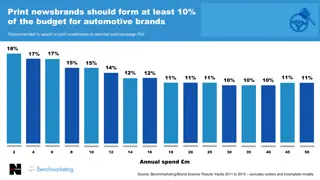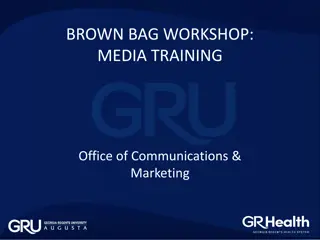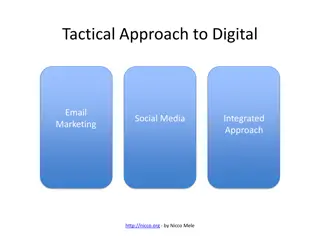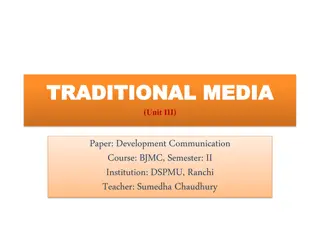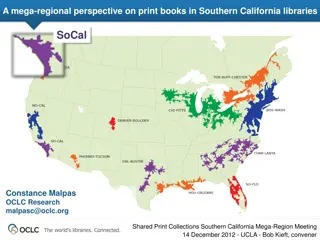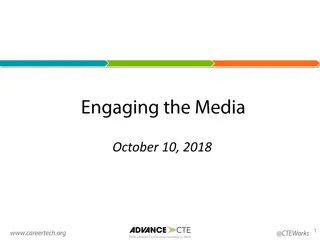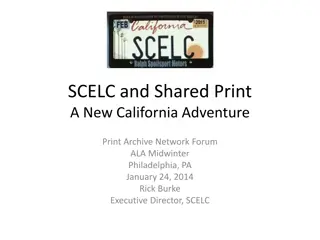
Brand Strategy and Market Positioning Guide
Explore the essential elements of brand strategy, market positioning, and targeting to define goals, identify prospects, determine timing, geography, and competitive advantage for successful marketing campaigns. Understand how to differentiate your brand, create a unique brand personality, and achieve competitive edge against rivals.
Download Presentation

Please find below an Image/Link to download the presentation.
The content on the website is provided AS IS for your information and personal use only. It may not be sold, licensed, or shared on other websites without obtaining consent from the author. If you encounter any issues during the download, it is possible that the publisher has removed the file from their server.
You are allowed to download the files provided on this website for personal or commercial use, subject to the condition that they are used lawfully. All files are the property of their respective owners.
The content on the website is provided AS IS for your information and personal use only. It may not be sold, licensed, or shared on other websites without obtaining consent from the author.
E N D
Presentation Transcript
Objectives What are your goals? Targeting Who are your best prospects? Timing When to market the product/service? Geography Where to concentrate your efforts? Positioning What s your place relative to competition? Brand personality Human characteristics of your brand? Competitive Advantage What differentiate your brand? Then do the Creative Brief
Action/Sales objectives focused on direct action, such as a buying response Goal: generate short-term increases in sales. Be realistic. Ex. 1-2% increase Goal: increase visits to brand website. Between sales and communication. Ex. 5-7% increase Communications objectives focused on building awareness or image. Goal: improve comprehension of a product feature. Ex. 8 to 10% increase Goal: build awareness of brand. Ex. 15-20% increase
Action Desire Conviction Comprehension Awareness
Determining your best prospects Not all prospect groups should be targets Must prioritize among possibilities Primary, secondary, tertiary markets Users, buyers, and influencers Research identifies prospects Strategy defines targets Start by defining them demographically, but also include lifestyle, attitudes, & media Profile them to create a portrait - be specific/vivid
What parts of the country? What types of markets? What areas of a market? Regions, DMAs, metro rings MRI-Simmons data on census/marketing regions and county size (A/B/C/D) What times of the year? What holiday seasons? What other timing factors? Time of year, month, week, and day
What is your place in the market? How are you understood by consumers? What can you deliver to consumers? Do you accept the current brand position? What human characteristics/personality traits can be attributed to your brand? What traits do you want associated with the brand? Must be something consumer can relate to
What give you an edge on competitors? A unique set of features that are seen as significant and superior by consumer Key to brand loyalty and brand equity Cost Maximize value to consumers (Walmart) Differentiation Unique experience (Apple) Niche Focus on narrow market (Rolex) Key to determining your USP - Unique Selling Proposition
Like the ROI Springboard Technique 7 Question Strategy Format 1. Who are you talking to? 2. What's your point? 3. What's the key word? 4. Why should I care? 5. Why should I believe you? 6 What do you want me to do? 7. How should I feel? Use language of the heart.
As you finalize the campaign strategy, you should also revisit the situation analysis to focus on those aspects that the account strategy addresses Chekhov's gun every element in a narrative must be necessary, and irrelevant elements should be removed - a gun shown in Act 1 must be fired by Act 3. Attributed to Russian playwright, Anton Chekhov. Sections on public opinion, media coverage, media use of prospects, and category creative may be used to introduce those sections. Other elements eliminated.
Function of Media Planning Media Planning Objectives/Strategies Media Selection Media Information Sources Media Outlets and Options
Function of Media Planning Media Planning Objectives/Strategies Media Selection Media Information Sources Media Outlets and Options
Goal: Delivering ad to target audience The Big Decisions: Which audience? Where? When? How long? Increasing complexity of media planning
The ideal moment for exposure to ad Consumer in info-seeking mode Consumer in purchase mode Interest and attention are high
Reaching the target: vehicle selection Geography: where to advertise Timing: when to advertising Duration: how long to advertise
Matching info on: Target audience profile Mass media audiences Categories of information: Audience demographics Product user characteristics
Geographic sales differences Differential dollar allocations Brand sales by region BDI: Brand Development Index Category sales by region CDI: Category Development Index Regional distribution patterns Focus ad expenditures on where the product is available Core markets or hubs Spot market emphasis on core locations Ex. Airlines targeting hub locations
MSI = ------------- CDI BDI Relative performance - how does the brand perform relative to the category?
High BDI Low BDI High CDI High share of market; good market potential A keeper!!! Low share of market; good market potential What is wrong? Low CDI High share of market; poor market potential Can we sustain? Low share of market; poor market potential Bail
Seasonal timing Holiday timing Days-of-the-week timing Hours-of-the-day timing When is as important as Where
Size of the advertising budget May need to select times to focus Consumer-use cycles When are sales highest, when is purchase? Competitors advertising Share of voice / Share of dollars
Continuity Flighting w/ hiatus Pulsing
Content context: compatibility with product Media clutter Share of voice in a given medium
Starting point is grounded in planning: Situation Analysis and Account Strategy Media objectives What are the media goals? Strategy: Media selection Finding the most appropriate media Flow Chart Scheduling Month-by-month budget allocation
Important factors: Area sales patterns Month-by-month sales/demand patterns Distribution patterns Competitors advertising patterns
Media selection based on: Audience research Media costs Important factors: Media popularity/usage Media audience profiles Media cost forecasting Media characteristics
Purpose Coverage lots of reach blanket the market Targeting focused on core demo - narrowcast Support media to remind and reinforce Audience/Product Involvement High vs. Low Involvement Type of Appeal Rational (Cognitive) vs. Emotional (Affective)
Print Media Place Media Broadcast Media Narrowcast Media Digital / Interactive Media More on this in Week 12/13
Print Media Newspapers National Newspapers Metro Daily Newspapers Regional Daily Newspapers Local Weekly Newspapers Magazines General circulation magazines Specialized Magazines Trade Magazines
Mass market (relatively wide coverage) Metro market coverage of some demos Readership increases with: Age Education Income
Geographic targeting + High credibility + Permanence/User-paced + High information potential + Poor reproduction quality - One day life span - Unattractive layouts - Hard to measure actual exposure - Massive decline in readership -
Coverage medium Geographic targeting Local retail ads High involvement consumers/products Rational appeals
High color reproduction quality + High credibility + Permanence/User-paced + Pass along factor + High information potential + Hard to measure actual exposure - Longer lead times - Expensive: High CPMs - Decline in readership, esp. news magazines -
Highly specialized target marketing Geographic targeting with zip editions High involvement consumers/products Rational and emotional appeals












